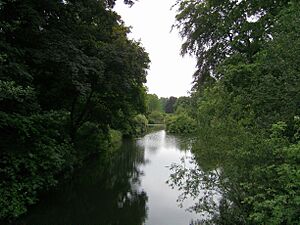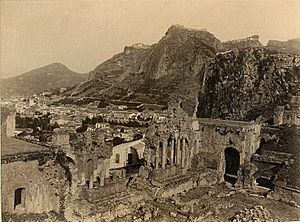The Wodehouse facts for kids
The Wodehouse is a very important historic country house near Wombourne, Staffordshire. It was once the main home of Sir Samuel Hellier, who loved music and designed gardens in the 1700s. Later, Colonel Thomas Bradney Shaw-Hellier, who directed the Royal Military School of Music, lived there. For nearly 200 years, the family owned a famous violin called the Hellier Stradivarius.
People say The Wodehouse has not been sold for over 900 years, even though the family line has sometimes ended.
Contents
The House, Gardens, and Estate
The Wodehouse is located by the Wom Brook, east of the village. The land around it has been there since medieval times. The main house itself was listed as a Grade II* building in 1953 by English Heritage, a group that protects old buildings. The stable block and coach house were also listed in 1963. The old farmhouse and mill, built in the early 1700s across the road, were also listed as Grade II* in 1973. Later, in 1987, the barn, the dam over the mill pool, and the path over its other end were also listed as historic.
In the mid-1700s, The Wodehouse became a place for art and music. Some parts, like a special building called Handel's temple, were designed by James Gandon, a famous architect. We only have drawings of the garden features today. Old books about Staffordshire from the 1800s mention the Shaw Hellier family, but strangely, not The Wodehouse itself. However, in 1848, a writer named Samuel Lewis described it as "a grand house in the Elizabethan style, located in a beautiful valley."
The house has parts that are from the 1300s, with additions from the 1600s and new designs inside from the 1700s. It was fixed up by George Frederick Bodley, an architect who liked old Gothic styles, in the 1870s. Later, in the 1890s, Charles Robert Ashbee, an artist and designer, added a billiard room and a chapel. He also added many decorative parts to the outside. In 1912, after the estate changed hands, an architect from Wolverhampton named J.K.H.E. Lavender worked on it. The gardens continued to be open to the public sometimes. For example, in 1936, The Wodehouse joined the National Gardens Scheme, a program where private gardens open to the public. As recently as 2011, it hosted a meeting for a local gardens trust.
In 1984, a history book about south-west Staffordshire called The Wodehouse one of the "three great houses" in the area. Around the year 2000, a writer named Michael Raven said The Wodehouse was "unspoilt." He described the house as having "a certain calm and mysterious charm" and the whole property as looking like an "early medieval settlement."
People Who Lived There
The 1700s: Sir Samuel Hellier
Samuel Hellier bought The Wodehouse by the 1720s. He studied at Oxford University and loved learning new things, especially from other countries. He had a large library and an important collection of musical instruments. He died in 1751. His only son, also named Samuel, was 14 and an orphan, as his mother had died earlier. One of his kind guardians was Charles Lyttelton, who encouraged him to study at Oxford. As a young man, he wanted to get married but never did, partly because of money problems.
Even with money worries, he managed to redesign The Wodehouse's large gardens. He became High Sheriff of Staffordshire, a position that was then the main law enforcement officer for the county. He was knighted in 1762. Besides his famous collections, he also collected beautiful or unusual items. For example, a gold cane handle showing symbols of local families was given to the Ashmolean Museum.
Sir Samuel spent a lot of money collecting musical treasures, including instruments and new music books. He was very interested in Handel, a famous composer. A museum exhibition about Handel called Sir Samuel one of the people who showed how much they loved music in the late 1700s. He was also an important person at the Three Choirs Festival, one of the oldest music festivals in the world.
For centuries, the families at The Wodehouse were closely connected to the Church of England and the local church in the village. The church has many memorials to them. Sir Samuel gave money to both the old Wombourne church and the new St John's Church, Wolverhampton, which opened in 1760. He gave an organ to his local church. His letters with the organist about how to play have been found and are very interesting to music historians.
Sir Samuel's grandmother lived to be 99. He died less than two years later, in 1784. He never married and left his property to his lifelong friend, Thomas Shaw. Thomas Shaw was a minister at St John's Wolverhampton. A condition of inheriting the property was that he had to change his name to Shaw-Hellier. So, in 1786, Reverend Shaw became Shaw-Hellier. He lived at The Wodehouse with his wife Mary. He died in 1812. His son James died in 1827. The family continued to have strong ties with St. John's Wolverhampton. In 1820, a daughter of the house married the minister there. Several sons from the family became ministers too.
The 1800s: Colonel T. B. Shaw-Hellier
For a time in the mid-1800s, Thomas Shaw-Hellier, the grandson of Reverend Thomas Shaw, rented out The Wodehouse. He loved hunting and preferred to live at other country homes. While he was away, Philip Stanhope, 1st Baron Weardale, a politician who worked for peace, and his wife Alexandra Tolstoy, lived at The Wodehouse for a while. Stanhope was elected to Parliament in 1886. A famous guest at The Wodehouse during this time was William Ewart Gladstone, who was a Prime Minister.
The second important musical person from The Wodehouse was Colonel Thomas Bradney Shaw-Hellier (1836–1910). He had a career in military music. He spent several years as the leader of the Royal Military School of Music at Kneller Hall. A prize for music composition there was named after him. He was in charge of the music part of the Royal Military Exhibition in Chelsea in 1890. During this five-month event, he brought 74 military bands from all over the country to perform. A large collection of musical instruments, especially wind instruments, was shown. He also helped organize celebrations for a music company. In his military career, he became a commander of the 4th Royal Irish Dragoon Guards.
He was also a farmer who raised Jersey cattle. Like Sir Samuel, he supported the church. He gave an altar and other items to Winchester Cathedral to celebrate 500 years of Winchester College.
The 1900s and 2000s
In 1898, Thomas Bradney Shaw-Hellier married Harriet Bradney Marsh Evans. They were distant cousins. He was over 60, and she was almost 60, so they had no children. Their marriage was difficult, and he decided to leave England and start a new project. He moved to Sicily, Italy. One of his friends there was the artist Robert Hawthorn Kitson. Another friend was the writer Robert Smythe Hichens. In 1907, Shaw-Hellier asked Ashbee, who had worked on The Wodehouse earlier, to build him a marble villa on a hilltop. They named it Villa San Giorgio, after the patron saint of England. This villa is now the Hotel Ashbee.
Colonel Shaw-Hellier died in Sicily in 1910. The estate then went to his nephew, Evelyn Simpson, who changed his name to Shaw-Hellier. When Evelyn died in 1922, the estate went to his daughter, Evelyn Mary Penelope Shaw-Hellier, because his son had died in World War I. The two surviving Shaw-Hellier sisters lived in The Wodehouse. They kept their connections with the church and village, even donating money to build a second church. They were described as "delightfully Edwardian" and liked "fast motoring." The last sister died in 1980. The Wodehouse, still not sold, then passed to distant relatives, the Phillips family. They live there privately but sometimes open the house and grounds to the public. The Wodehouse still has a large collection of old drinking glasses, portraits, and porcelain.
There is a road named Shaw Hellier Avenue in nearby Brierley Hill, named after the family.
Musical Legacy
The musical collection is most linked to Sir Samuel Hellier. However, the most valuable item, the Hellier Stradivarius, was owned by the family even before him. Those who came after him also kept or added to the music books and instruments. The Hellier Stradivarius violin, made around 1679, was created by Antonio Stradivari in Cremona, Italy. An instrument expert company says it was owned by Sir Edward Hellier in 1734. It's possible that he bought it directly from the old violin maker himself. The family kept it for almost 200 years. In 1880, Colonel Shaw-Hellier sold it, but he bought it back ten years later. When he died in 1910, it left the family. Today, it is cared for by the Stradivari Foundation in Cremona and is on display at the Museo del violino.
In the 1960s, a group called the Galpin Society found a hidden treasure of musical items in a room in the stable block. A researcher who helped list the items in the 1970s said it was rare to find a collection where both instruments and music books survived. However, the collection was split up soon after. The instruments went to the Edinburgh University Collection of Historic Musical Instruments. One specific trumpet, chosen by Sir Samuel Hellier, has been written about in many journals. The other half of the collection, the written music, went to the music library of the Barber Institute of Fine Arts at the University of Birmingham. This collection has 860 items, including rare copies of musical works. Also, still at The Wodehouse, are 165 letters Sir Samuel wrote to his estate manager. These letters explain how instruments should be played and stored, which is very helpful for people who study music history.
Non-musical gifts were also given to museums. For example, a model of a 64-gun ship from the late 1700s was given to the Pitt Rivers Museum in the late 1800s.
See also
- Donington le Heath Manor House Museum, a house from the same time as The Wodehouse
- List of country houses in the United Kingdom
- Grade II* listed buildings in South Staffordshire
- Listed buildings in Wombourne



